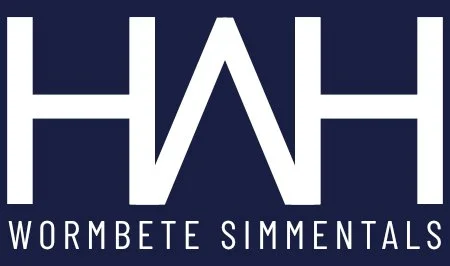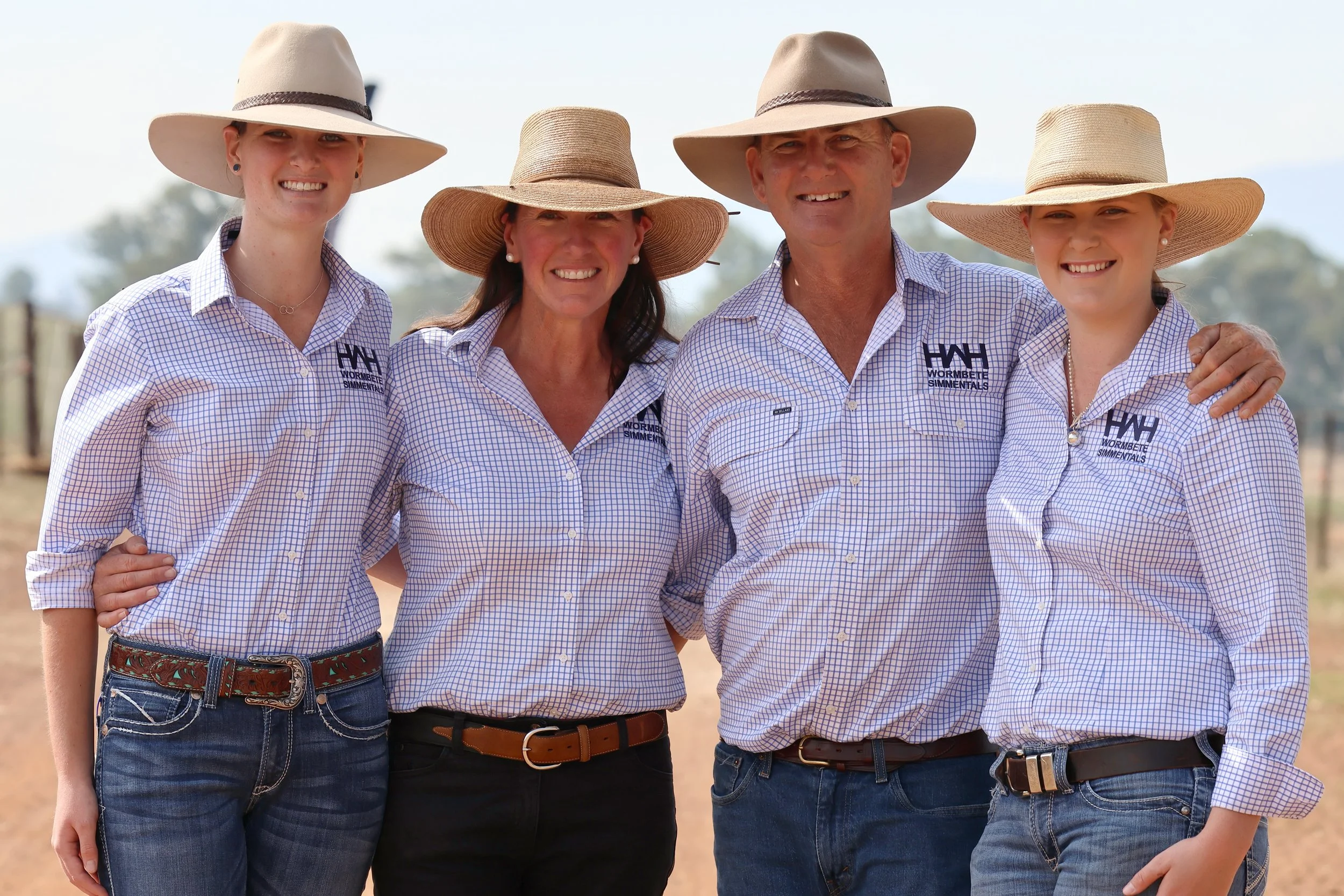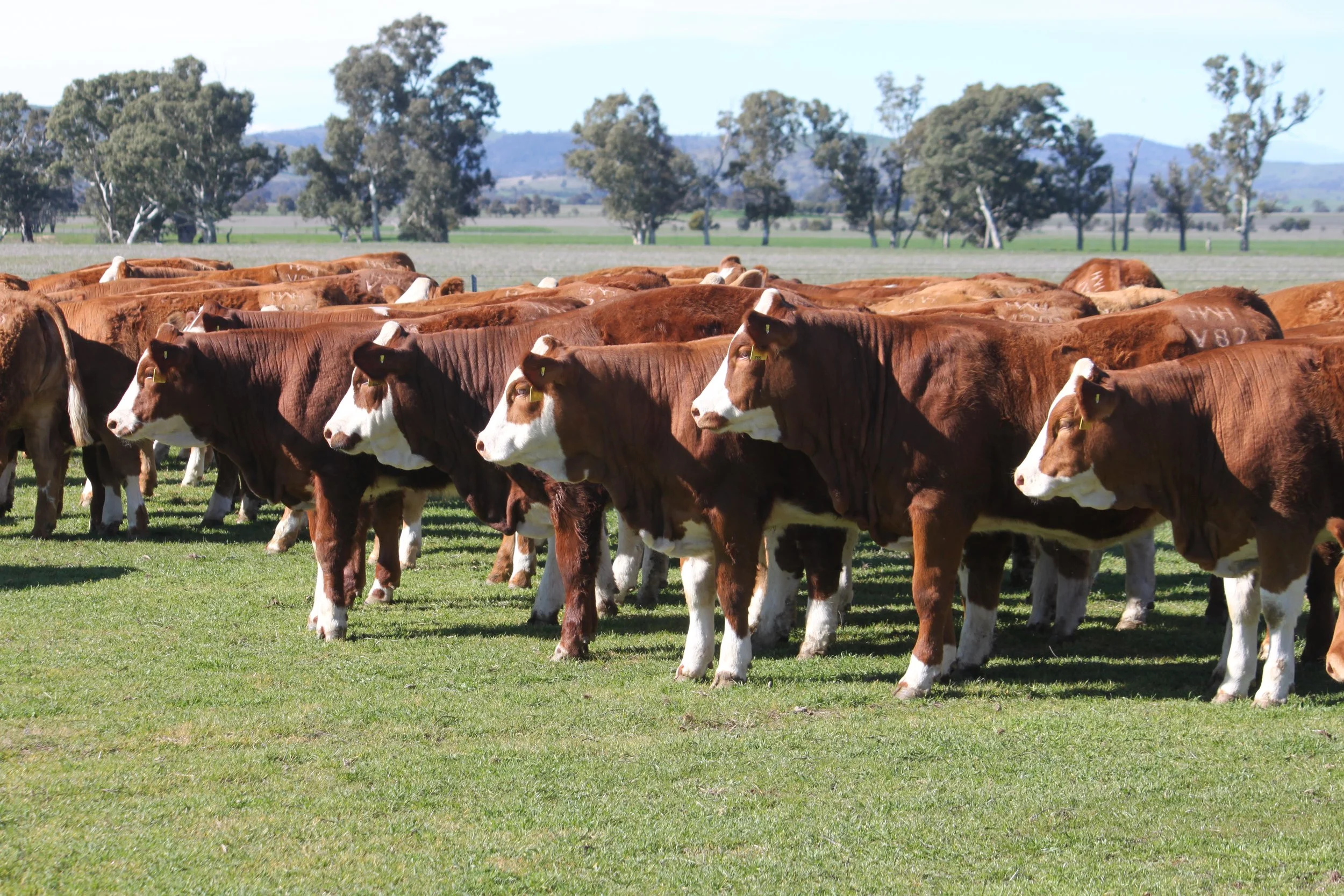About us
Wormbete Simmentals began in 1972 under the vision of Henry W. W. Hopkins, who introduced Simmental genetics early in the breed’s Australian history.
Today the legacy continues at “Allawah”, Illabo under the care of John and Nicole Hopkins and our daughters Mim and Judy. We bring a shared passion, knowledge and a deep commitment to the Simmental breed.
We continue to operate the stud with clear objectives . . . to breed cattle that meet market demands, support our clients’ success and help shape the future of Simmentals in Australia.
Our heritage and story
Wormbete Simmentals was established in 1972, with our founder Mr Henry Hopkins one of the first to introduce Simmental genetics to Australia.
Originally located on the property “Wormbete” at Winchelsea in Victoria, the home of Wormbete Simmentals is now the mixed farming property “Allawah” Illabo, which is approximately 50 minutes north east of Wagga Wagga in New South Wales.
For over 50 years we have continued the high standards and goals set for the stud to ensure only bulls and females of quality, early maturity, structural correctness and calm temperament are produced.
The range of farming enterprises on “Allawah” include cattle, sheep and cropping and requires our beef herd to consistently perform to meet the benchmarks we have set. It is this consistent performance combined with the strength of our genetics throughout our long commitment to the breed that enables our cattle to prosper under a range of conditions and consistently achieve top prices in the market.
Breeding Simmental cattle for 50 years has resulted in a herd that today is formidable in its quality, consistency, genetic strength and performance. The depth of knowledge of our female genetics is combined with a commitment to performance recording, structural assessment, herd health and embrace of new technologies and genetics.
Read more from Henry Hopkins about the foundation of our Stud below ….
Foundation of Wormbete Simmentals
We encourage you to read this delightful insight into the introduction of Simmentals to Australia and the foundation of Wormbete Simmentals.
It is a captivating read on how Henry became hooked on the breed, the establishment of the Australian Simmental Breeders Association and the introduction of performance recording. Henry was a past president of the ASBA and was awarded a life membership to the breed in 2010. His passion and vision never wavered and it is these strong principles that continue to underpin Wormbete Simmentals today.
Written by HENRY HOPKINS in February 2013
(1933 – 2014)
My interest in the Simmental breed started many years ago when I had a small Shorthorn stud. I had a great friend in Penola, Dick Kidman, who was introducing weight gain and more muscle into the breed, starting a form of performance recording, which interested me from the beginning.
It is interesting to look back to a sale at Melbourne Show time when the Auctioneer mentioned the fact that one of the bulls in the ring had been “performance recorded”. The attendance burst out laughing and in some cases jeering! We have come a long way since then.
I was fortunate enough to be awarded a Nuffield Scholarship in 1966. On my way to the U.K. I had an opportunity to visit Kenya and for the first time I saw Simmental cattle at a show there. I was completely hooked from that time on.
The Wormbete Simmental stud was one of the original studs to import Simmental semen from the U.K. I have always believed it important to have large numbers of cattle to work with to enable those that are not up to standard to be “classed out.” Several hundred cattle were used in our insemination program
As one of the original councilors from Victoria I was involved in the formation of the breed in Australia. WHAT AN OPPORTUNITY WE HAD! The council very quickly moved forward in the banning of fostering and made it compulsory that all cattle were dehorned, and of-course introduced a system of performance recording which is now accepted by so many breeds of cattle in Australia.
Council was a very unselfish and generous team with representatives from every state. Our first President was Dick Vincent from Western Australia, whose contribution to the breed was enormous. I became the second President for 12 months, Dick then taking office for a further term of 3 years.
It gave me great pride to be acknowledged 2 years ago with Life membership of the Simmental Society.
The Wormbete stud pushed forward with good numbers, our aim was to have cattle that would perform well in Australian conditions, sound feet, legs, with early maturity etc. We continued large artificial Insemination programs backed up with other prominent Australian bulls and soon began to develop cattle that we were very proud of.
We had several sales on the property while at Winchelsea. Later the stud withstood several property moves in its’ entirety, proving it had the ability to adapt and remain strong in a variety of conditions.
For 15 years the stud has been at “Allawah” Illabo NSW where my son John and his wife, Nicole continue the strong breeding objectives we have always believed so fundamental. They have shown great ability in moving the stud forward.
A further aim in the development of the stud was to have a high standard of horned cattle before introducing the polled gene. This has now worked well with their advancements that I am very excited about. Finally I would like to make a warning to breeders of the future, to be very wary and careful of following “fashions” which has caused considerable trouble to some in the past.
My faith in the breed has never wavered; it has all the traits we would wish to have, milk, growth, muscle and considerable fertility, all in this one breed.
Henry W.W Hopkins




